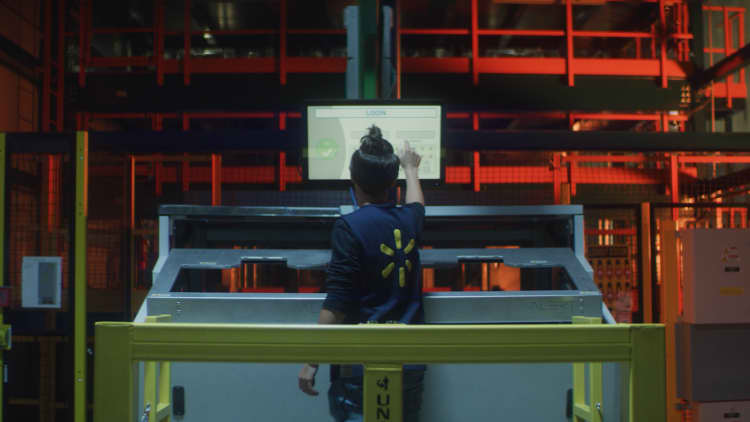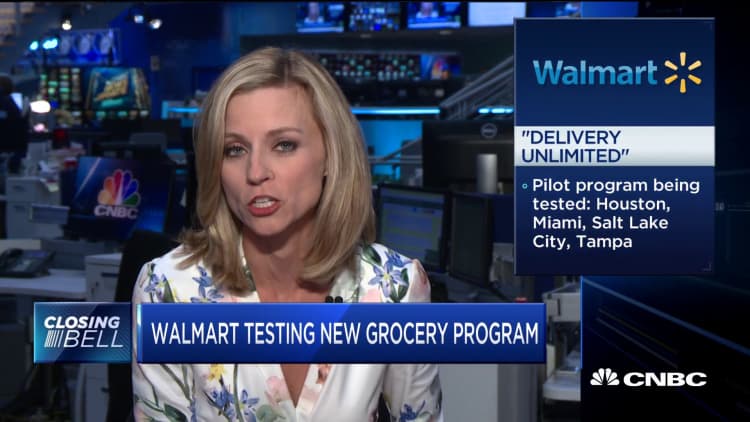
SALEM, New Hampshire — Walmart thinks it has a technological weapon that will enable it to pick, pack and deliver shoppers' online grocery orders faster as the company tries to strengthen its foothold as America's largest grocer.
The big-box retailer on Wednesday unveiled a platform called Alphabot, which it has stealthily been testing at one of its Supercenters in Salem, New Hampshire, since the middle of last year. Walmart says the Salem store will continue to serve as Alphabot's "home," while the new picking and packing process is analyzed again and again, and improvement are made. It says it will eventually assess plans for a broader rollout across the U.S.
"Groceries [are] playing a great role in e-commerce growth," Tom Ward, senior vice president of central operations, told CNBC in an interview. "We're seeing that customers really enjoy using the service and that's why we keep trying to innovate in the space. ... We're really pleased with what we've seen in the last 12 months."
Walmart's grocery business has been on fire, especially online. That's good for the retailer: Grocery sales account for 56% of Walmart's total U.S. revenue.
But the company is facing more and more competition in the space from Amazon, which bought Whole Foods in 2017, and traditional players in the category like Costco and Kroger who are also adapting to consumers increasingly shopping online.
In its latest reported quarter, Walmart said it was a strong grocery business that played a "meaningful" role in helping boost its digital sales by 41%. It said grocery comparable sales climbed a mid-single-digit rate, better than general merchandise. Total revenue was up 2.5% to $127.99 billion, from $124.89 billion a year earlier.
Walmart has been investing in the space to reap these gains. It is trying to make it easier and more appealing for customers to shop for food on the internet.

Today, it has nearly 3,100 pickup locations for online grocery orders across the U.S., with more than 1,400 stores offering same-day grocery delivery and about 1,400 pickup towers.
It also currently offers an "unlimited" option from 1,400 locations — where customers can pay $98 annually, or $12.95 monthly, for unlimited grocery deliveries. And it has started testing delivering groceries directly to customers' refrigerators in three U.S. cities, which costs users $19.95 a month. It has said it plans to scale this offering "aggressively."
Still, Walmart, Amazon, Kroger and others in this business know the concept of ordering groceries online is still in its early stages, especially in the U.S. The trend has hardly gotten its legs off of the ground, analysts say.
A mere 3% of grocery spending takes place online in the U.S., according to Bain & Co. research. Meanwhile, in regions such as the U.K. and South Korea, online grocery penetration can be as high as 15%.
But online grocery sales are expected to capture as much as 20% of total grocery retail by 2025, reaching $100 billion, based on a separate study by the Food Marketing Institute conducted by Nielsen. That gives Walmart, and Alphabot, a lot of room to run.

How it works
The technology was developed solely for Walmart by a start-up based in Massachusetts called Alert Innovation. The two have been working together since 2016.
Alphabot itself spans about 8,000 square feet and operates inside a roughly 20,000-square-foot space that looks like a mini warehouse and has been built onto the back of Walmart's Salem store. It took roughly two years to construct. Walmart isn't disclosing the cost of this technology or of the construction.
Alphabot uses autonomous carts to retrieve the shelf-stable foods, refrigerated items and frozen goods that people are ordering online. It can hold upward of 20,000 items, Walmart said. And the retailer is stocking its most popular grocery items — like cereals, frozen vegetables and peanut butters — there.
Once the carts have the items they're looking for, the Alphabot system sends them to designated work stations, where a Walmart employee will then check the items to ensure the order is accurate, bag everything and finish the delivery.
Walmart says this cuts time compared with how the grocery picking and packing has traditionally been done. As it stands in all other Walmart stores today, workers must walk around the sales floor and find the items themselves. Walmart says workers in Salem will continue to pick produce and other "fresh" items by hand, however, as those goods need to be checked for brown spots or other damage.
"By assembling and delivering orders to associates, Alphabot is streamlining the order process, allowing associates to do their jobs with greater speed and efficiency," Brian Roth, a senior manager of pickup automation and digital operations for Walmart U.S., said in a statement.
"Ultimately, this will lower dispense times, increase accuracy and improve the entirety of pickup grocery," he said. "And it will help free associates to focus on service and selling, while the technology handles the more mundane, repeatable tasks."
Ultimately, Walmart says Alphabot will cut the time it takes to pick and pack an online grocery order, thereby allowing shoppers to order even more at the 11th hour. And they shouldn't have to wait as long after ordering to be able to pick it up.
Walmart is currently planning to construct two additional Alphabot facilities, at stores in Mustang, Oklahoma, and Burbank, California, which will kick off next fiscal year. It says these spaces will be smaller than 20,000 square feet because it wanted to have more room in Salem for its first trial run of the technology, just in case.
Walmart doesn't see a day where this technology is in all of its stores. Instead, one Alphabot could serve multiple Walmart locations in the future, it said.
"With all the technologies that we use, you have to look at whether you need it," Ward said. "And so, you know, we're not going to roll things out just for the sake of having it."
Walmart says there are other advantages — like the ability to collect and share data about groceries and shoppers' habits. It says Alphabot will be learning as it moves so that, over time, its "stocking will get more intelligent." Because of this, Walmart says it will be able to anticipate, for example, what a customer might want as a replacement if what they order is out of stock.
"Whether it's an autonomous vehicle or whether it's something like the Alphabot system you guys have seen today ... I would say that we lean into things where it makes economic sense for us as a business," Ward said. "And if it allows us to keep the costs down and ... keep the business investing back in price ... which is what this will do."



